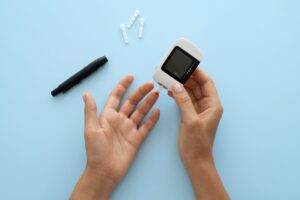The Common Complications of Diabetes
Diabetes is a chronic condition that burdens millions around the world with serious health complications. Learning about the experts on the most common diabetic complications can help you manage your diabetes better and help you improve your quality of life more than you imagine. The following article discusses the many uncontrollable outcomes of diabetes and explains how treatments can prevent — and in some cases even delay – the onset of some complications.
Understanding Diabetes and Its Complications
Diabetes is a chronic illness that interferes with the process that the body uses to process glucose or sugar. The significant kinds of diabetes are Type 1 and Type 2, both of which can cause severe health conditions if not checked effectively.
This article will offer a brief overview of some of the common complications of diabetes, including cardiovascular disease, high blood sugar levels, nerve damage, kidney damage, eye damage, and foot difficulty. Causes, symptoms, and preventive measures will be described; it’s essential to understand these topics to deal more effectively with diabetes overall.
Short-term Effects
High blood sugar levels can cause immediate and noticeable issues. These short-term effects can impact your daily life and overall well-being.
- Frequent Urination: High blood sugar levels make your kidneys work harder, leading to more frequent trips to the bathroom.
- Increased Thirst: As you urinate more often, your body loses fluids, making you feel thirsty all the time.
- Fatigue: High blood sugar levels can make you feel tired and weak.
- Blurred Vision: Excess sugar in your blood can affect your eyes, causing temporary blurred vision.
- Headaches: Fluctuating blood sugar levels can lead to frequent headaches.
- Infections: High blood sugar weakens your immune system, making you more prone to infections.
Managing these short-term effects is crucial. Proper blood sugar control can help prevent these immediate issues and improve your quality of life.
Long-term Damage
High blood sugar levels over an extended period can lead to severe and lasting health problems. These long-term complications can significantly impact your quality of life and overall health.
- Cardiovascular Disease: Chronic high blood sugar can damage your heart and blood vessels, increasing the risk of heart attack and stroke.
- Nerve Damage (Neuropathy): Prolonged high blood sugar can harm nerves, leading to pain, tingling, and loss of sensation, especially in the hands and feet.
- Kidney Damage (Nephropathy): Diabetes can damage the kidneys’ filtering system, potentially leading to kidney failure.
- Eye Damage (Retinopathy): High blood sugar can damage blood vessels in the retina, causing vision problems and potentially leading to blindness.
- Foot Problems: Nerve damage and poor blood flow to the feet increase the risk of serious infections and foot ulcers, which may require amputation.
- Skin Conditions: Diabetes can make you more susceptible to skin infections and disorders.
Addressing these long-term complications is vital. Regular monitoring and management of blood sugar levels can help prevent these severe issues and maintain your health.
Understanding Diabetic Neuropathy
Diabetic neuropathy is nerve damage that results from uncontrolled high blood sugar levels related to diabetes. It tends to affect any nerve in the body, leading to physical manifestation in different segments of the body. It is essential to discern the differences between the types of nerve damage when researching and prevention.
Peripheral Neuropathy
Diabetic neuropathy is the most common form of neuropathy. This type of diabetes is mellitus. It is a distal symmetrical polyneuropathy. It can affect an individual similarly in both legs and may progress to the arms through the abdominal, back, buttocks, and legs. Hence, it is also known as stocking-and-glove neuropathy. It can progress from mild sensory changes to more severe symptoms, including numbness, tingling, pain, and burning discomfort, and increasing over the years to a point where muscle weakness and loss of reflexes occur. Diabetic neuropathy increases the likelihood of foot injuries and infections that can cause complications.
Autonomic Neuropathy
Autonomic Neuropathy affects the autonomic nervous system, i.e., the body’s involuntary body functions. This nerve damage can affect the regulatory system control. Symptoms may include heartburn, indigestion, bloating, difficulty swallowing, diarrhea, constipation, sweating, bladder problems, sexual dysfunction, and abnormal blood pressure regulation—and can lead to many other problems that affect the organs. It also disrupts an individual’s social and occupational life.
Proximal Neuropathy
Proximal neuropathy, also called diabetic amyotrophy, helps nerves in the thighs, hips, buttocks, or legs to weaken, typically only affecting one side of the body. This can cause severe pain in these areas and eventually lead to muscle weakness and difficulty rising from a sitting position. It can lead to pain and muscle weakness that can stop the ability to move – or even stand up individually. Proximal neuropathy, unlike any other type of neuropathy, is a painful condition, and the proximal muscle weakness is often accompanied by significant weight loss due to pelvic limb muscle breakdown. In many patients, such weight loss results in the diagnosis of cancer or tuberculosis. Even if the proximal neuropathy progresses or if the pain does not resolve after a few months, additional treatments may not be needed. The disorder often improves within the next few months, but recovery is typically slow.
Focal Neuropathy
A localized pain in the front of the leg, between the shoulder and the chest, or in one part of the eye suddenly could be a result of one nerve being damaged and being recognized as localized neuropathy, unlike other kinds, which makes the whole experience of pain hypersensitive. Focal neuropathy symptoms usually resolve over a few weeks or months, but some can be permanent. The nerve damage of focal neuropathy is usually sudden (acute) occurring primarily on a single nerve or a group of nerves located within the same region of body parts, resulting in sudden pain, weakness, or paralysis in these specific areas that are attacked with this sudden pain.
Symptoms and Management
Diabetic neuropathy can cause a variety of symptoms depending on the type and severity of nerve damage. Recognizing these symptoms early helps to manage diabetes.
General Symptoms of Diabetic Neuropathy
- Numbness or reduced ability to feel pain or temperature changes
- Tingling or burning sensation
- Sharp pains or cramps
- Increased sensitivity to touch
- Muscle weakness
- Loss of reflexes, especially in the ankle
- Digestive issues (constipation, diarrhea, nausea)
- Bladder problems (incontinence, frequent urination)
- Sexual dysfunction
- Abnormal blood pressure (dizziness or fainting when standing up)
- Sweating abnormalities (excessive or reduced sweating)
- Problems with body temperature regulation
- Sudden, severe pain in specific areas
- Weakness or paralysis in affected areas
By recognizing these symptoms and seeking early intervention, you can manage diabetic neuropathy more effectively and maintain a better quality of life. Don’t forget about regular health checks.
Foot Problems in Diabetic Patients
Diabetes patients commonly experience foot problems that can lead to severe complications like poor blood circulation and nerve injury. Patients frequently develop ulcers, which are open sores. These sores are most often found in high-pressure areas of the foot, such as the toes or heel. Because of nerve damage, a diabetic may not feel pain in their foot when they step on something, such as a tack or pebble, which could cause a foot ulcer.
They can quickly become infected and grow into severe conditions whenever an individual with diabetes doesn’t feel something as innocent as a minor cut or blister. Infections escalate fast and may pose higher risks like gangrene due to bacteria being unfaught with less sugar present.
Inadequate circulation can cause skin to become dry and cracked, making infection more imminent. People at risk of foot ulcers need to manage their feet and footwear guidance with frequent inspection, washing, and applying lotions as described by their specialists. Complications in the early stages include diabetic retinopathy and should also be addressed rapidly to avoid them evolving into a more significant threat to your health.
Prevention and Treatment
Diabetic patients need to take good care of their feet in order to preserve their health and prevent serious complications. Both as preventative measures and for treatment guidelines, regular health checks are highly beneficial. Patients with diabetes need to check their feet for cuts, blisters, red spots, and swelling daily as part of their foot problem prevention strategy. Keeping feet clean and moisturized is an essential part of control that is only routinely emphasized once there is dry, cracked skin, which can lead to the entry of bacteria and infections.
This includes patients avoiding walking barefoot, which in turn can help to prevent injuries. Trimming toenails straight across and carefully smoothing any sharp edges can go a long way in preventing a problem that can lead to infection by creating a painful ingrown toenail. In cases of a foot issue, immediate care from a medical professional is recommended. Not only can early intervention keep minor issues from becoming debilitating infections or ulcers, but it could also save a diabetic’s foot with timely and appropriate treatment. Treatment may involve cleaning and dressing wounds, administering antibiotics to manage infected lesions, and, in instances that are more advanced, removing the infected tissue surgically. Podiatrists can offer several services, including comprehensive foot exams, custom orthotics, and customized advice regarding the best footwear.
Additionally, keeping blood sugar within recommended levels will also diminish the downfalls that are contributed by high blood sugar. Hence, among the ways to prevent or treat diabetic foot problems can be summed up as taking care of your feet daily, using needles and appropriate footwear always, and, if something comes up, not waiting to call a doctor. By way of conclusion, timely, routine foot hygiene, ensuring proper footwear, and immediate medical intervention could go a long way in preventing or treating foot conditions in diabetic patients, and regular check-ups with health care providers should be embraced to support managing or lessen the risk.
Take free consultation if you have problems.
The Link Between Diabetes and Heart Disease
One of the complications that can come with diabetes is heart disease and problems with coronary artery. Raised blood sugar levels within the body will begin to cause damage to the nerve fibers and compete for control over the heart. Because of this, you can end up with something such as a heart attack, incidence atrial fibrillation problems or a stroke.
Diabetics build up fat in their bloodstream, which can lead to other risk factors. The risk is increased even further if it is not appropriately managed with medications to keep their blood sugars under control. Getting and keeping blood glucose, blood pressure, and blood cholesterol under control is essential to reducing the risk of heart disease and stroke in patients who have diabetes. That’s why you have to manage diabetes carefully.
The Role of Regular Health Checks
Regular health checks and screenings are essential in managing diabetes health. They control blood sugar, provide early warnings of complications, and adjust treatment if necessary. Regular checkups and hospice care safeguard against conditions such as neuropathy, foot ailments, and cardiovascular risks in their early stages. The LifeChoice team‘s comprehensive long-term management strategies could reduce the toll of diabetes in the long run by minimizing the vulnerability of people living with this chronic condition to prevent serious health consequences.
To learn more about how LifeChoice Hospice and Palliative Care recognizes and treats diabetes end-of-life signs and symptoms, please call 847-777-8888.






Post Comments